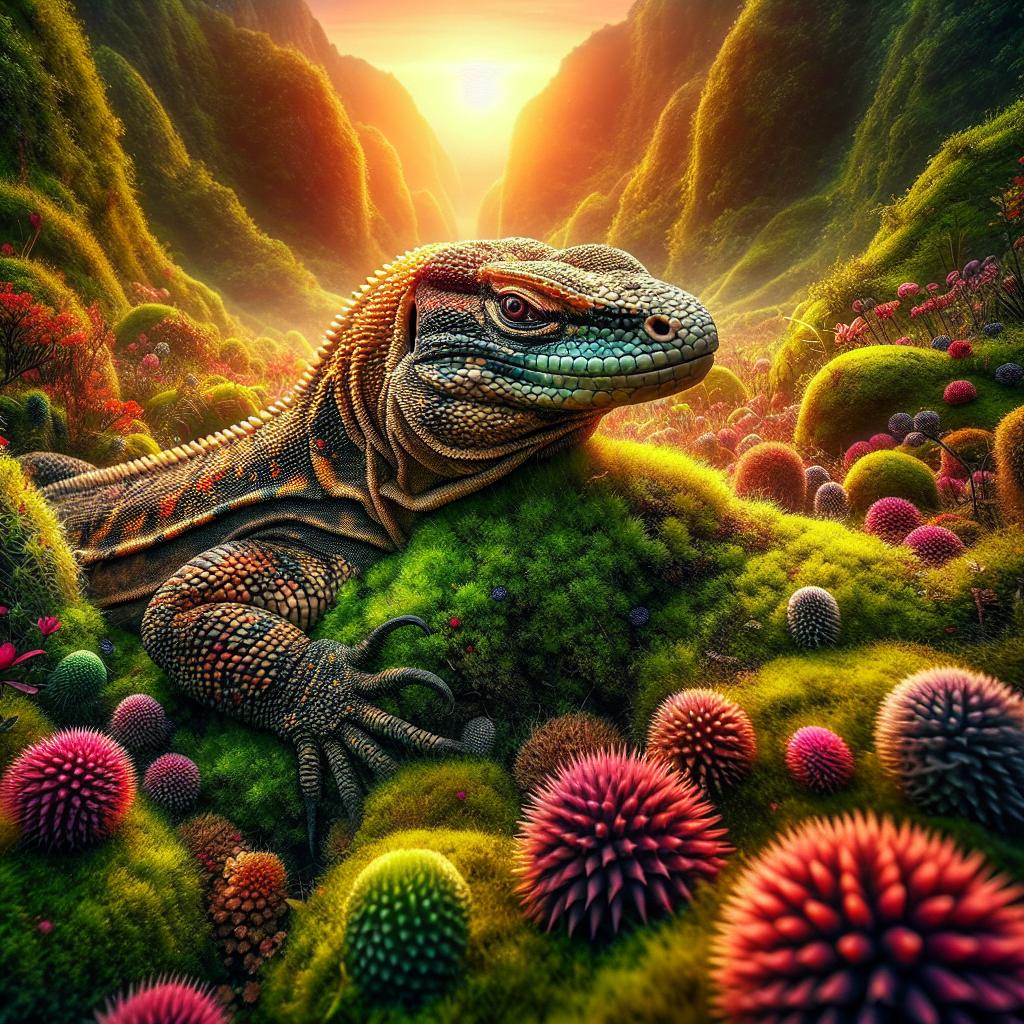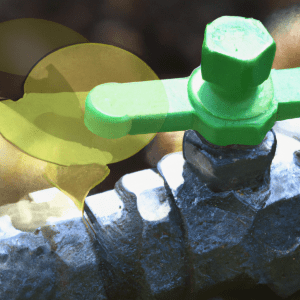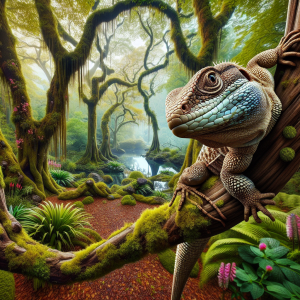Introduction: Importance of Microclimates in Landscaping for Reptiles
Have you ever considered how the tiny microclimates in our landscaping can make a world of difference for our scaly friends? Picture this – I once stumbled upon a small lizard basking in the sun on a rock in my backyard. It struck me that even these little creatures have their own preferences when it comes to their living conditions.
Understanding the needs of lizards in landscaping is key to creating a thriving outdoor environment for them. These reptiles rely on specific conditions like temperature, humidity, and shelter to feel at home. Just like us, they appreciate a cozy spot to relax in!
When it comes to crafting ideal microclimates for reptiles, it’s all about getting into the nitty-gritty details. From providing ample sunlight for basking to creating shaded areas for retreat, every element plays a crucial role in ensuring their well-being. It’s like setting up a mini oasis right in your backyard!
Did you know that selecting the right plants can greatly enhance the lizard habitats in your landscaping? Some plants offer shelter and hiding spots, while others attract insects for the lizards to feed on. It’s like building a buffet for our reptile buddies right in our own garden!
Maintaining optimal conditions for reptile health involves a bit of TLC and regular monitoring. By keeping an eye on the temperature, humidity levels, and overall habitat setup, we can ensure our scaly pals are happy and healthy. It’s like being a reptile caretaker, but with a green thumb!
As we delve deeper into the world of lizard landscaping and microclimates, the possibilities are endless. With a little creativity and a touch of nature, we can transform our outdoor spaces into havens for these fascinating creatures. So, are you ready to embark on this reptile-friendly landscaping adventure with me?”
Understanding the Needs of Lizards in Landscaping
Have you ever thought about how lizards adapt to different environments, especially in our own backyard landscapes? It’s fascinating to see how these reptiles thrive in varying conditions. Understanding the needs of lizards in landscaping is like uncovering a hidden world within our own gardens.
Let me share a fun fact with you – did you know that lizards are ectotherms, meaning they rely on external sources to regulate their body temperature? This makes creating suitable microclimates in landscaping crucial for their overall well-being. Think of it as setting the stage for a reptile-friendly paradise right in your own yard!
When considering the needs of lizards in landscaping, it’s essential to remember that these creatures require specific conditions to thrive. From the type of vegetation to the temperature and humidity levels, every aspect plays a vital role in creating a habitat that mimics their natural environment. By understanding these requirements, we can design a landscape that not only enhances the beauty of our outdoor space but also provides a safe haven for our scaly friends.
Imagine walking through your garden and spotting a lizard basking in the sun among the lush foliage. It’s moments like these that make all the effort worth it. By incorporating elements that cater to the needs of lizards, we not only attract these fascinating creatures but also contribute to the biodiversity of our surroundings.
So, the next time you’re planning your landscaping project, consider the needs of lizards and how you can create microclimates that cater to their specific requirements. It’s a rewarding experience that brings us closer to nature and allows us to appreciate the intricate balance of life in our own backyard.
Creating Ideal Microclimates for Reptiles
So, when it comes to creating ideal microclimates for reptiles in your landscaping, it’s all about understanding the specific needs of these amazing creatures. I remember when I first delved into this topic, I was fascinated by how intricate and essential the environmental conditions are for reptiles to thrive.
Did you know that reptiles, such as lizards, require a well-balanced microclimate to regulate their body temperature effectively? It’s not just about providing a sunny spot for basking; it’s about creating a diverse environment that mimics their natural habitat. This brings us to the fascinating world of designing and maintaining microclimates for reptiles in your landscaping.
One practical tip that I found incredibly helpful is to research the specific species of reptiles you want to cater to. Different lizards have varying requirements when it comes to temperature, humidity, and shelter. By understanding their needs, you can tailor your landscaping efforts to provide the best possible environment for them.
As you embark on this reptile-friendly landscaping journey, it’s essential to consider the broader implications of your actions. By creating a habitat that supports local reptile populations, you are not only enhancing your outdoor space but also contributing to the conservation of these fascinating creatures.
Now, imagine walking through your garden and spotting a vibrant lizard basking in the sun or seeking refuge in a cozy hideaway you’ve created just for them. The joy of seeing wildlife thrive in your carefully crafted microclimates is truly rewarding and adds a whole new dimension to your landscaping experience.
So, dive into the world of creating ideal microclimates for reptiles in your landscaping, and let’s transform your outdoor space into a haven for these captivating creatures!
Selecting Suitable Plants for Lizard Habitats
Have you ever considered the impact of plant selection on creating a lizard-friendly landscape? It’s not just about aesthetics; the right plants can directly contribute to the well-being of your scaly friends. Picture this: you walk into a garden teeming with lush greenery, and your pet lizard is basking in contentment amidst the foliage. Choosing suitable plants for your lizard habitat is like curating a personalized oasis for them.
Let me share a fascinating fact with you – did you know that certain plants can help regulate the temperature and humidity levels in a lizard enclosure? By strategically incorporating vegetation that provides shade and retains moisture, you can mimic the natural microclimates that lizards thrive in. This not only creates a visually appealing landscape but also ensures that your reptilian companions feel right at home.
When it comes to selecting plants for your lizard landscaping, opt for species that are non-toxic and safe for reptiles. Avoid plants with thorns or spines that could potentially harm your pets. Additionally, consider the size and growth habits of the plants to prevent overcrowding and maintain a harmonious balance within the ecosystem. By choosing a diverse mix of vegetation, you can create a dynamic environment that caters to your lizards’ needs.
Imagine strolling through your backyard and witnessing your lizards exploring their habitat, interacting with different plants, and soaking up the sun in their favorite spots. It’s a rewarding experience to see your landscaping efforts translate into a thriving ecosystem for your reptilian companions. So, take the time to research and select the perfect plants that will not only enhance the beauty of your garden but also provide a safe and enriching environment for your lizards to enjoy.
Maintaining Optimal Conditions for Reptile Health
When creating ideal microclimates for reptiles in your landscaping, it’s crucial to understand the specific needs of these fascinating creatures. Lizards, in particular, have unique requirements to thrive in their environment. Picture this – a friend of mine once decided to introduce a bearded dragon into their backyard oasis without considering the importance of maintaining optimal conditions for reptile health. As a result, the poor lizard struggled to acclimate to the surroundings, highlighting the significance of creating a suitable habitat.
Now, let’s delve into an interesting fact about creating microclimates for reptiles. Did you know that lizards are ectothermic creatures, meaning they rely on external heat sources to regulate their body temperature? This knowledge is key when designing a lizard-friendly landscape, as it emphasizes the necessity of providing areas with varying temperatures to allow these cold-blooded creatures to thermoregulate effectively.
When selecting plants for your lizard habitats, it’s essential to consider not only aesthetic appeal but also functionality. Incorporating vegetation that provides hiding spots, basking areas, and edible plants can significantly enhance the overall quality of the microclimate for your reptilian friends. By choosing plants that mimic their natural habitat, you create a more enriching environment for your lizards to explore and thrive in.
As you embark on the journey of creating a reptile-friendly landscape, think about the challenges you might encounter along the way. One common mistake to avoid is overlooking the importance of monitoring and adjusting microclimates for lizards regularly. Environmental conditions can change, affecting the well-being of your reptile companions. By staying vigilant and proactive in maintaining optimal conditions, you can ensure a vibrant and healthy landscape for your lizards to enjoy.
Remember, every small detail in your landscaping design can make a significant difference in the well-being of your reptile friends. By understanding and meeting the specific needs of lizards, you can create a harmonious environment where they can thrive and flourish. So, get creative, stay informed, and watch your lizard landscaping project come to life in a way that benefits both you and your scaly companions!
Tips for Enhancing Reptile-Friendly Landscaping
Imagine this: you’ve put so much effort into creating a beautiful landscape in your backyard, complete with lush greenery and decorative features. But have you ever thought about how to make it a haven for your scaly friends, the lizards? That’s where reptile-friendly landscaping comes in.
Let me share some tips for enhancing your outdoor space to cater to these fascinating creatures. Picture this – you can strategically place rocks and logs in your garden to create basking spots for lizards. Not only does this mimic their natural habitat, but it also provides them with a cozy place to soak up the sun. Plus, it adds a rustic charm to your landscaping!
Another fun idea is to incorporate native plants that attract insects, which are a staple in a lizard’s diet. By planting a variety of vegetation, you’re not only beautifying your garden but also ensuring a sustainable food source for your reptilian visitors. It’s like hosting a buffet for them right in your backyard!
Now, here’s a thought-provoking question for you: have you considered adding a small pond or water feature to your landscaping? Lizards love to drink and bathe in shallow water, so by including a water element, you’re not only creating a refreshing oasis but also catering to their hydration needs. Just imagine the sight of lizards leisurely sipping from the pond on a sunny day – it’s a win-win for both you and your reptile pals!
By following these simple yet effective tips, you can transform your garden into a lizard paradise. So, why not take your landscaping to the next level by making it a welcoming environment for these fascinating creatures? Your backyard will not only look stunning but also become a thriving ecosystem where lizards can thrive happily.
Common Mistakes to Avoid in Lizard Landscaping
Have you ever heard about the common mistakes people make when creating lizard-friendly landscapes? It’s quite fascinating to explore the dos and don’ts of designing microclimates for our scaly friends.
Imagine this – you spend hours carefully selecting plants and arranging rocks to create a perfect environment for your lizards, only to realize that you unknowingly placed a heat lamp too close to a plant, causing it to wither away. These little missteps can happen to anyone, but being aware of potential pitfalls can save you time and effort in the long run.
One common mistake that many beginners make is underestimating the importance of temperature gradients within the lizard habitat. Lizards, like most reptiles, require a range of temperatures to regulate their body heat effectively. Placing all heat sources on one side of the enclosure can lead to overheating or inadequate warmth, disrupting the natural behavior of your reptiles.
Another pitfall to avoid is neglecting the need for hiding spots and basking areas in the landscaping setup. Lizards need places to retreat and feel secure, so incorporating rocks, logs, or artificial shelters can provide them with essential hiding spots to reduce stress and promote natural behaviors.
Moreover, it’s crucial to pay attention to the lighting conditions in your lizard landscaping. Improper lighting can disrupt the reptiles’ circadian rhythms and impact their overall well-being. Choosing the right UVB and heat lamps, along with providing shaded areas for relief, is key to a successful lizard habitat.
By understanding and sidestepping these common mistakes, you can ensure that your lizard landscaping project thrives and provides a safe and enriching environment for your reptilian companions. So, next time you’re designing a microclimate for your lizards, remember to keep these tips in mind to create a harmonious and sustainable habitat for your scaly friends.
Incorporating Water Features for Reptile Environments
Have you ever thought about adding a water feature to your lizard-friendly landscaping? It’s not just for aesthetics; it can actually benefit your reptile buddies in more ways than one. Picture this: a small pond or a shallow water basin strategically placed in your lizard habitat. Now, here’s an interesting fact: some lizard species, like the Green Anole, love to bask in the sun near water sources to regulate their body temperature. So, incorporating a water feature can provide a dual purpose of hydration and thermoregulation for your scaly pals.
Now, let’s dive deeper into why adding a water feature can be a game-changer for your reptile landscaping. Not only does it offer a hydration spot for lizards to drink from, but it also creates a microclimate with increased humidity levels, which certain lizard species thrive in. This additional moisture in the air can mimic their natural habitat and contribute to their overall well-being.
Imagine sitting in your garden, watching your lizards enjoy a refreshing drink or even taking a dip in the water feature. It adds a whole new dimension to your landscaping project, don’t you think? Plus, it’s a great conversation starter for guests who visit your outdoor oasis. You can share fun facts about how your water feature is not just for show but also serves a vital purpose in keeping your reptile friends happy and healthy.
So, if you’re looking to elevate your lizard landscaping to the next level, consider the benefits of incorporating a water feature. It’s a practical and visually appealing addition that can enhance the microclimate of your reptile habitat while providing a unique and enriching experience for both you and your scaly companions.
Monitoring and Adjusting Microclimates for Lizards
Have you ever wondered how to monitor and adjust microclimates for your lizard’s habitat? It’s like being a weather scientist for your reptilian friends! Keeping a close eye on the temperature, humidity levels, and overall conditions in their environment can make a world of difference in their well-being.
Let me share a personal anecdote with you. One time, I set up a mini weather station in my backyard to keep track of the conditions in my lizard’s enclosure. It was fascinating to see how even small changes in sunlight exposure or watering routines could impact the microclimate inside the habitat. By regularly monitoring these factors, I was able to make adjustments to ensure my lizard was always comfortable and thriving.
Adjusting microclimates for lizards is not just about setting it and forgetting it. It requires a bit of trial and error to find the perfect balance. Think of it as a science experiment where you get to play the role of a caring reptile scientist. By observing how your lizard reacts to different conditions and making adjustments accordingly, you can create a custom-tailored environment that meets their specific needs.
Remember, each lizard species may have slightly different requirements when it comes to their microclimate. Some may prefer warmer temperatures, while others thrive in slightly cooler settings. By understanding your lizard’s natural habitat and behavior, you can fine-tune their environment to mimic the conditions they would experience in the wild.
So, the next time you’re checking on your lizard, take a moment to assess the microclimate in their habitat. Is the temperature just right? Do they have enough hiding spots to regulate their body heat? By making small tweaks based on your observations, you can ensure that your scaly friend is living their best lizard life in a carefully curated microclimate.
Conclusion: Enjoying a Vibrant Landscape with Happy Reptiles
Imagine trying to create the perfect microclimate for your pet lizard in your backyard. It sounds like a fun challenge, right? Well, did you know that lizards are ectothermic creatures, meaning they rely on external heat sources to regulate their body temperature? Understanding this fact is crucial when designing a landscaping setup that caters to their specific needs.
When setting up a microclimate for your reptile buddies, it’s essential to consider factors like temperature, humidity, and shelter. Lizards thrive in environments that mimic their natural habitats, so incorporating heat lamps or rocks for basking spots can help them regulate their body temperature effectively.
One interesting tidbit to keep in mind is that different species of lizards have varying requirements when it comes to microclimates. For instance, desert-dwelling species may need a hotter and drier environment, while tropical lizards prefer warmer and more humid conditions. By understanding these nuances, you can tailor your landscaping efforts to suit the specific needs of your pet reptiles.
Creating a lizard-friendly microclimate in your landscaping not only benefits your scaly friends but also adds a unique touch to your outdoor space. Picture lush greenery, strategically placed rocks for climbing, and cozy hideouts for your lizards to explore and enjoy. It’s like bringing a slice of the wild into your backyard!
So, the next time you step into your garden, envision a mini oasis designed to cater to your pet lizard’s needs. By paying attention to the intricate details of creating a microclimate, you’re not just landscaping – you’re crafting a specialized haven for your reptilian companions to thrive and bask in the warmth of their personalized paradise.




